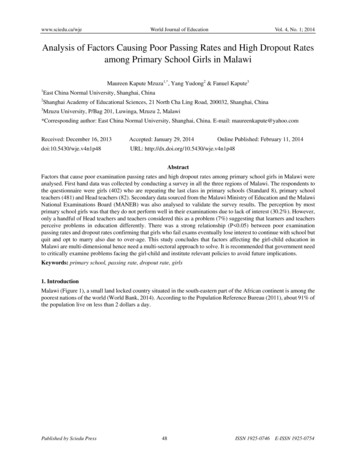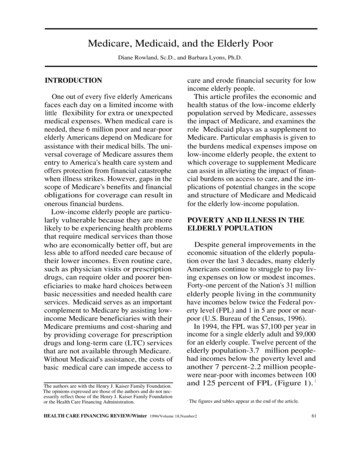
Transcription
www.sciedu.ca/wjeWorld Journal of EducationVol. 4, No. 1; 2014Analysis of Factors Causing Poor Passing Rates and High Dropout Ratesamong Primary School Girls in MalawiMaureen Kapute Mzuza1,*, Yang Yudong2 & Fanuel Kapute31East China Normal University, Shanghai, China2Shanghai Academy of Educational Sciences, 21 North Cha Ling Road, 200032, Shanghai, China3Mzuzu University, P/Bag 201, Luwinga, Mzuzu 2, Malawi*Corresponding author: East China Normal University, Shanghai, China. E-mail: maureenkapute@yahoo.comReceived: December 16, 2013Accepted: January 29, 2014Online Published: February 11, 2014doi:10.5430/wje.v4n1p48URL: rs that cause poor examination passing rates and high dropout rates among primary school girls in Malawi wereanalysed. First hand data was collected by conducting a survey in all the three regions of Malawi. The respondents tothe questionnaire were girls (402) who are repeating the last class in primary schools (Standard 8), primary schoolteachers (481) and Head teachers (82). Secondary data sourced from the Malawi Ministry of Education and the MalawiNational Examinations Board (MANEB) was also analysed to validate the survey results. The perception by mostprimary school girls was that they do not perform well in their examinations due to lack of interest (30.2%). However,only a handful of Head teachers and teachers considered this as a problem (7%) suggesting that learners and teachersperceive problems in education differently. There was a strong relationship (P 0.05) between poor examinationpassing rates and dropout rates confirming that girls who fail exams eventually lose interest to continue with school butquit and opt to marry also due to over-age. This study concludes that factors affecting the girl-child education inMalawi are multi-dimensional hence need a multi-sectoral approach to solve. It is recommended that government needto critically examine problems facing the girl-child and institute relevant policies to avoid future implications.Keywords: primary school, passing rate, dropout rate, girls1. IntroductionMalawi (Figure 1), a small land locked country situated in the south-eastern part of the African continent is among thepoorest nations of the world (World Bank, 2014). According to the Population Reference Bureau (2011), about 91% ofthe population live on less than 2 dollars a day.Published by Sciedu Press48ISSN 1925-0746E-ISSN 1925-0754
www.sciedu.ca/wjeWorld Journal of EducationVol. 4, No. 1; 2014Figure 1. Political Map of Malawi Showing Its Neighbouring CountriesSource: www.theodora.com/mapsIn Malawi, education is one of the most important sectors often ranked second from agriculture. In fact, schooling isconsidered to be one of the most important levers for increasing the populations living conditions in Malawi. Theeducational system in Malawi is categorized into three main divisions namely, primary schools, secondary schools andtertiary. Primary school runs from Standard 1 to 8 (eight years). The official entry age into primary school level ofeducation is 6 years though variations appear (Kadzamira & Rose, 2001). Students write final exams in primary schoolin Standard eight to qualify for entry into secondary school. Primary education is therefore the most important of theeducation system in Malawi because it forms the foundation for knowledge gain into secondary and eventuallyuniversity education. However, illiteracy levels in Malawi are higher among women and also most girls perform poorerthan boys and eventually drop out of school. It is reported that only 67.3% of women is literate versus 76.5% for men(World Bank Report, 2010). In fact, Malawi is ranked as one of the countries in the southern Africa region with thehighest girl drop-out rates among girls (Milner et al., 2001).Another notable change in the primary school in Malawi is the tremendous increase in students’ enrolment from 1994following introduction of the free primary education by the government (Milner et al. 2001). Consequences of thisincluded shortage of teachers and teaching/learning resources in primary schools.This study was carried out to establish if the increased enrolment of students into Primary Schools in Malawi hasindeed affected the examination passing rate in standard eight of primary schools in Malawi with a focus on girls;determine reasons for poor examination passing rates among girls compared to boys and also to determine reasons forhigh dropout rates amongst girls in primary schools in Malawi.2. Materials and Methods2.1 Research DesignA structured questionnaire was administered to 42 Head teachers, 481 teachers, and 402 girl students (those repeatingStandard 8) from selected primary schools in all 3 regions (southern, central and northern) of Malawi in January 2013(Table 1). The questionnaire was structured in such a way that it would help in soliciting from respondents (teachers,Published by Sciedu Press49ISSN 1925-0746E-ISSN 1925-0754
www.sciedu.ca/wjeWorld Journal of EducationVol. 4, No. 1; 2014Head teachers and girls repeating standard eight) reasons why most girls in Malawi do not perform well in theirstandard eight examinations and also why eventually most of these girls drop out from school.To quantify and validate findings from the questionnaire, secondary data e.g. on students’ enrolment, number ofteachers, examination pass rate etc were also collected from the Malawi National Examinations Board (MANEB) andthe Ministry of Education in Malawi.Table 1. Structure Dimension and Target Population for SurveyTarget populationGirl studentsTeachersHead teachers(402)(481)(82)Number of item(s) in corresponding questionnaireDimension1. Socio-cultural factorsa) General reasons why most girls fail examsb) Inside school reasonsc) Outside school reasons2. Economic factorsa) Inside school reasonsb) Outside school reasons3. Political factorsa) Outside school reasons4. Other factorsa) General2.2 Data Analysis41693513149121212222445Data were entered into the computer Microsoft Excel then analysed using SPSS Statistical Package Version 15.0.Regression analysis was carried out to check for correlation between different variables e.g. student enrolment versusexamination passing rate. Analysis of variance (ANOVA) was used to compare examination passing rate means amongyears. Simple T-tests were computed to compare examination passing rates between boys and girls over years.Descriptive graphs were plotted to show trends over years in students’ enrolment, examination passing rates etc.3. Results3.1 Increased Students Enrolment versus Number of Teachers and SchoolsIt was apparent from the secondary data (Figure 2) that indeed the introduction of the free primary education after 1994resulted into high numbers of students enrolled into primary schools in Malawi.Published by Sciedu Press50ISSN 1925-0746E-ISSN 1925-0754
World Journal of EducationVol. 4, No. 1; 0Number of students enrolledwww.sciedu.ca/wjeYearFigure 2. Enrolment of Students into Primary Schools in Malawi between 1994 and 2010Source: Ministry of Education Basic Education StatisticsIt was also clear that the increased number of pupils enrolled into primary schools in Malawi was not accompanied byincreased number of teachers and learning class rooms. For example, studies show steadily increasing pupil to classroom ratio in primary schools in Malawi (Figure3).Pupil Classroom ratioPupil classroom rFigure 3. Pupil Class Room Ratio in All Primary Schools from 2005 to 2010Source: Ministry of Education Basic Education Statistics3.2 Examinations Pass Rate between Boys and Girls in Primary Schools in MalawiData from the Malawi National Examinations Board (MANEB) (Figure 4) showed that the examinations pass rate forgirls was much lower than that of boys.Published by Sciedu Press51ISSN 1925-0746E-ISSN 1925-0754
www.sciedu.ca/wjeWorld Journal of ls78.5276.3263.0456.7266.5768.2867.2959.6759.8Vol. 4, No. 1; 8462.6856.9557.1455.932000 2001 2002 2003 2004 2005 2006 2007 2008 2009 2010 2011YearFigure 4. Primary school Leaving Certificate Examinations Pass Rate From 2000-2011Source: Data kindly provided by the Malawi National Examinations Board (MANEB)There were statistically significant differences in pass rates between boys and girls in the primary schools in Malawi(Table 2)Table 2. Analysis of Variance for Pass Rates between Boys and Girls from 2000 to 2011Source of VariationBetween GroupsWithin 823.57263F23.71088P-value7.23E-05F crit.4.3009493.3 Drop-out Rates between Boys and Girls in Primary Schools in MalawiThe number of students enrolled for both boys and girls (but more girls) was generally much higher in Standard 5 butsignificantly dropped on the way up to Standard 8 (Figure 5).Boys: Std 5Girls: Std 5Boys: Std 8Girls: Std 8Survival rate 26.102005200620072008Year20092010Figure 5. Survival Rate in Standards 5 and 8Source: Education Statistics, 2010This suggests that many girls dropped out of school before reaching Standard 8 which is the final class in primaryschools in Malawi hence high dropout rates in girls than boys. These results are backed by observations (Figure 6)where more girls repeat classes than boys.Published by Sciedu Press52ISSN 1925-0746E-ISSN 1925-0754
www.scieduu.ca/wjeWorld JournalJof 500.4400.330200.20.100.0000.79Vol. 4, No. 1; 2014Malee0.7770.770.7990.6440.370.160.11 0.066Netenrolmentrate0.000utDrop-ourateRepetitioon Qualifiedd Completioonrateteachers ((%)rateIndicatoorFiguree 6. Net Enrolmment, Drop-Ouut Rate, Repetittion Rate and CCompletion RaateSource: Malawwi Ministry of EEducationIt was wortth noting that thhere were moree male qualifiedd teachers thann female (Figurre 6) which apppears to corresppond tothe high dropout rates in thet girls.3.4 Reasonns for Poor Peerformance in Primary Schoools as Reporteed by Girls reppeating Standaard Eight of PrimarySchoolOut of 402 repeater girls interviewedi(Figure 7), most of them reportted lack of interrest (30.2%) ass the major reasson fortheir not performing welll in their examminations. Thee other consideerable reasons included poveerty (16.2%), llack oflearning annd teaching matterials (10.9%) such as textboooks, classroomms, desks; and sshortage of teacchers (8.4%). LLack ofparental caare (6.5%) wass also mentionned like in casees where one or both parentts are dead or parents are noot welleducated hence they don’’t motivate or civicceducate annd encourage tthe girls on thee importance off education.Percent 08.43.12.84.46.53.75.62.83.4Respoonses from rrepeater girlssFiguure 7. Responsees from Repeaater Girl to Pooor Examinationn Passing RatessOther minoor reasons inclluded peer pressure (5.6%), doing househoold jobs (4.4), high pupil to teacher ratio ((3.7%),relationshipps with boys (33.4%) and abseenteeism (3.1%%).Published byy Sciedu Press533ISSN 1925-07446E-ISSN 19225-0754
www.scieduu.ca/wjeWorld JournalJof EducaationVol. 4, No. 1; 20143.5 Reasonns for Poor Perfrformance in PrimaryPSchoolls as Reported by TeachersOut of 481 Primary Schoool Teachers thhat were interviiewed (Figure 8), a majority perceived thatt lack of teachinng andlearning materialsm(18.3%%), lack of mootivation due to poor salariees and lack off accommodatiion (16.2%), llack ofparental suupport (13.1%)), lack of role models (11.4%%) and early fforced marriagges and pregnaancies (10.5%%) werereasons thaat consequentlyy caused girls notn to perform well in exams.Percent 82.34.74.21.62.10.02.11.91.9Responses fro m teachersFigure 8. Responnses from Teacchers to Poor EExamination Paassing RatesOther factoors included laack of learners’ interest (6.8%%); relationshiips with male tteachers and bboys (4.7%) annd peerpressure (44.2%).3.6 Reasonns for Poor Perfrformance in PrimaryPSchoolls as Reported by Head MasteersOut of 42 HeadHteachers innterviewed (Figure 9); many of them (16.7%%) blamed earlyy marriages annd pregnancies amonggirls as thee main reason forf their poor performancepinn exams. Lack of parental caare and supportt to girls was aanothernotable reaasons mentioneed by Head teaachers (14.3%). Lack of rolee models, peerr pressure and poverty (9.5%%) alsofeatured high as reasons forf girls’ poor resultsrin examminations.Published byy Sciedu Press544ISSN 1925-07446E-ISSN 19225-0754
www.scieduu.ca/wjeWorld JournalJof EducaationPercent frequency18.016.014.012.010.08.06.04.02.00.0Vol. 4, No. 1; Respponses from Head teacheersFiguure 9. Responsees from Head TeachersTto Pooor Examinatioon Passing RateeThe other reasonsrincludeed lack of teachhing and learniing materials, llack of learnerrs’ interest and also the conceern thateight years of primary schhool is too longg for girls (7.1%%). Shortage oof teachers and inadequate leaarning time weere alsomentioned as other minorr reasons causing poor perforrmance in girlss’ examination.3.7 Summaary of Causes ToT Girls’ Poor Passing Rate fromfAll the ReespondentsAfter summmarising all responses from the girls repeaating Standard eight in selected primary scchools, their teeachers(who also oftenoare involvved in the formmation and marrking of Primarry School Leavving Certificatee Examinationns), andfinally the Head teachers in those respeective primary schools, majorr reasons that were mentioneed by all respoondentswere drawnn (Figure 10). FourFmajor reaasons were isolaated as: lack off teaching and learning materrials, lack of leaarners’interest, lacck of parental carec and poverrty and finally peerp pressure.Lack of teach//learn materialssLack of learneers interestLack of parenttal care & poveertyPeer pressureePercent 16.7215.2100.05.0511.96.85.64.27.19.50.00Repeaater girlsTeacherrsRespondeentsHeead TeacherssFiguure 10. Summaary of Responsees from Girls, Teachers and HHead TeacherssIt was appaarent that most girls don’t perfform well in their primary schhool examinations because thhey have no inteerest inpursuing academics (30.22%) and lack of parental caare which in mmost cases is ddue to povertyy (22.7%). Girrls alsohighlightedd lack of teachhing and learninng materials ammongst their pproblems. The latter (20.4%) and lack of parentalPublished byy Sciedu Press555ISSN 1925-07446E-ISSN 19225-0754
www.scieduu.ca/wjeWorld JournalJof EducaationVol. 4, No. 1; 2014care and pooverty (15.2%) ranked high among teacherrs while lack oof parental carre and poverty (16.7%) and llack ofteaching annd learning maaterials (11.9%%) were highlyy singled out bby most Head teachers as reasons for girlss’ poorperformancce in examinatiions.However, HeadHteachers anda teachers maym likely sharee similar views regarding perfformance of girrls at primary sschools.Responses from head teacchers and teachhers were thereffore averaged aand plotted agaainst those fromm girls. Indeed,, it wasvery strikinng to observe thhat while most girls still indiccated the probleem of lack of leearners’s intereest as the majorr causefor their pooor performancce at school, Heead teachers annd teachers didd not consider tthat as a probleem (Figure 11)).Repeater girrlsTeachhers & Headd teachersPercent 316.216.05.055.67.00.00Lackk ofteach/learnmaterrialsack ofLaleaarnersinterestLack ofpaarental care& poverty6.9Peer pressuureResponnsesFigure 11. AveragedARespponses from Teeachers and Heead Teachers veersus Girls' ReesponsesThis is a cleear suggestion that learners’ interestiis a verry important isssue that needs tto be seriously addressed. However,it appears thatt both girls anda teachers (HHead teachers anda teachers) aagreed that lackk of teaching annd learning maaterialsis a problemm that affects bothbof them. ThisT means thaat teachers are nnot able to deliiver their lessoons effectively and onthe other hand,hthe studeents (girls) are not able to cooncentrate andd understand thhe lessons beinng taught in class orpracticals in the laboratorry since there area not enough learning and teeaching materiials.4. Discussiion4.1 Increassed Pupil Numbbers versus Teaching and Learning ResourrcesThe sharp increaseiin students’ enrolmeent into primarry schools in MMalawi after 19994 is a clear inndication that indeedfinancial capacity is one of the major limiting factors to developmment. In a couuntry where mmore than 85% of thepopulation lives in rural areasa(FAO, 20011) and over 65%6live beloww the poverty lline i.e. on lesss than 1 US dolllar perday (MPRSSP, 2007), manny parents in reemote rural areeas are not ablee to pay schooll fees for their cchildren. Remooval offees was thherefore a very strong incentivve for poor loww income parennts to send theiir children to school.Though thee population off Malawi has moremfemales thhan males (Huuman Rights Coommission, 20005), more boyys wereenrolled coompared to girlls despite the primarypschool be free. This iindeed explains many challennges that girls face inMalawi thaat hinder themm from going furtherfuwith edducation. It is rreported that leess number off women attainns higheducation levelslthan menn in Malawi annd the SADC reegion (Sadie, 22005). Accordiing to the Worlld Bank, only 227% ofMalawi’s girls enrooll inseccondary schhool fromprimary scchool (Worrld Bank, 2010.http://databbank.worldbankk.org/ddp/homme.do) and jusst 13% will aattend (Educatiion Statistics, 2010). Furtheer, theincreased numbernof studeents being enroolled into primaary schools in MMalawi was noot accompaniedd by equal increase innumber of teachers resulting into acutee shortage of teeachers and leaarning classroooms. There weere highly signnificantdifferencess between pupiil to trained teaacher ratio and pass rate of exxams in Primarry Schools bettween 2005 andd 2009suggesting that indeed thee high pupil to trained teacherr ratio has a neggative impact oon the pass ratee of exams in pprimaryschool. Theese are two of thet four main inndicators of quality of school that were usedd by the Southerrn and Eastern AfricaConsortiumm for Monitorinng Educationall Quality (Milnner et al. 2011)). Graddy & Sttevens (2005) aalso reported thhe highPublished byy Sciedu Press566ISSN 1925-07446E-ISSN 19225-0754
www.sciedu.ca/wjeWorld Journal of EducationVol. 4, No. 1; 2014pupil to teacher ratio as one of the factors affecting pupil performance even in developed countries such as the UnitedKingdom.The observed correlation between the increased enrolment of pupils in primary schools in Malawi and the examinationpassing rate in standard eight (final grade) agree with studies from other countries (Graddy & Stevens, 2003). Surveyresults showed that one of the major causes of poor passing rate was shortage of teaching and learning resources (T/L),which could be due to the increase in students’ enrolment. Several studies have attempted to explain the link betweenthe learning environment and performance of the pupils (Wolff, 2010). Though it is argued that resource availabilitydoes not correlate with student achievement (Hanushek, 1997), the general observation as reported in this study is thatto the contrary, performance of students is directly linked to availability of learning resources also reported by Gulobaet al. (2010). Heyneman & Jamison (1980) observed that shortage of textbooks in Uganda negatively influenced pupilachievement. On the other hand, availability of resources resulted into higher pupil achievement (Graddy & Stevens,2005; Greenwald, 1996).After the introduction of free primary education in 1994, the government of Malawi resorted to a quick way ofincreasing number of teachers to match the increased pupils’ enrolment. This was a departure from the normal two yeartraining program for primary school teachers. Teachers were just recruited and allowed to start teaching without anyformal training. The recruitment of unqualified and untrained teachers may also have contributed to the poorperformance of pupils during examinations and consequently increased drop outs.High examination passing rates in Standard 8 of boys than girls may explain why not many girls enrolled into the freeprimary school in Malawi after 1994, have been successful to reach and pass the primary school leaving certificateexaminations that are done in Standard 8 (the final class in primary school).4.2 School Dropout amongst Girls in Primary Schools in MalawiFrom 78.5% of girls who enrolled into primary education in Malawi after introduction of the free primary educationcompared to boys (77%), not many of them attended classes normally (40% versus 47% for boys) and also many girlsdid not continue with school (dropped out). Many girls also repeated classes (15.5% against only 0.2% for boys).Probably this may explain why most of them dropped out. It is reported that Malawi has one of the highest schooldropout rates in southern Africa, with 15% of girls (three in every 20 girls), and 12% of boys (3 in every 25 boys),dropping out between Grades 5 and 8 of primary school (Education Statistics, 2010). In Malawi, girls are especiallypressured to abandon their education because they have to help out. It was interesting to note girls could get married asearly as in Standard 1 and 2 and become pregnant as early as Standard 2 (Table 3).Table 3. Number of Dropouts by Reasons, Standards and Sex 2009/2010REASONSStandard 1Standard 2Standard 3Standard 4Standard 5Standard 6Standard 7Standard GirlsBoysGirlsBoysFamily nceSource: Malawi Education Statistics, 2010This is a confirmation that the issue of early marriage and pregnancy among girls is a serious one.4.3 Responses from Girls repeating Standard Eight of Primary SchoolMost girls reported lack of personal interest as the major reason for them not performing well in their examinations.Girls could lose interest due to multiple factors such as lack of learning resources which was also mentioned in thisstudy and earlier reported by several authors (Guloba et al., 2010; Graddy & Stevens, 2005). The problem of over agePublished by Sciedu Press57ISSN 1925-0746E-ISSN 1925-0754
www.sciedu.ca/wjeWorld Journal of EducationVol. 4, No. 1; 2014which girls frequently mentioned during the survey including poverty could yet be more convincing reasons for theirlack of interest in school. So, while free primary education appears to be “free”, the reality is that it is not free becausestudents are required to purchase their own learning resources such as textbooks, school uniform, pens, and notebooks,which many families find difficult also reported by Kadzamira & Rose (2001) and Al-Samarrai & Zaman (2000). Also,due to poverty, parents resort to send girls to do piece work such as gardening and doing small business to earn a living.Most girls therefore are absent from school. However, this is not the case for boys. In Malawi, culture also plays a keyrole in that most parents opt to send boys to school than girls because of the thinking that they will help them in futurewhile girls will be married away. These reasons therefore suggest why rates for drop-outs are high. According toUNESCO, only 58% of children will complete a full course of primary school, and 20% of children repeat one or moreschool years, often several times, if they have had to take significant time out of school and have fallen behind(RIPPLE Africa, 2003-2012).Though entry age into primary school in Malawi is 6, in rural areas, this is still a small age due to long walkingdistances to school hence most children start school a little later than 6 years. Also, in view that primary school periodis 8 years i.e. from standard 1 to standard 8, even assuming that children start primary school at the age of 6, it meansthat they will be 14 years by the time they reach standard 8. Most girls in Malawi reach puberty after 10 years others asearly as 9 years. Therefore, by the time students leave primary school, many of them are far older than primary age,having repeated several years, and many lose interest and drop out altogether. For example, reports from the MalawiEducation Statistics (2010) show that some girls marry even while in standard 1 of primary school (Table 3). In fact,the study did not show any case for boys marrying until in standard 4.In this study, many girls also reported over age and complained about the length of the primary school system (eightyears) as reasons for failure at school. Many girls are caught up with age after puberty (12 years or more) and end upgetting married or impregnated while at school. After puberty, some parents especially in rural areas force theirchildren to marry. In recent years, this has been influenced by poverty as the parents are not able to take care of theirchildren. With the widespread problems of HIV-Aids, most girls have become victims of looking after their familyafter loss of parents or nursing sick relatives while boys are allowed to go to school. This may explain why Malawi hashigh dropout rates in girls than boys.4.4 Responses from TeachersMajority of teachers perceived that lack of teaching and learning materials, lack of motivation due to poor salaries andlack of accommodation, lack of parental support, lack or role models and early forced marriages and pregnancies werereasons that consequently caused girls not to perform well in exams. These responses appear to be the real situation onthe ground in Malawi as far as the education sector is concerned. As mentioned earlier, the lack of interest by the girlsis also attributed to lack of parental care especially when they are poor and are unable to support their children with themuch needed resources for learning. Probably, every teacher in Malawi will mention lack of motivation fromgovernment. Teachers in Malawi are probably the lowest paid civil servants and most of them lack properaccommodation and basic requirements. According to Kruijer (2010) the high numbers of pupils and lack of resourcesfor teaching has created frustration and lack of motivation in teachers to fully discharge their duties. Poor workingcondition for teachers can affect the quality of education in terms of student examination passing rate (Kruijer, 2010).4.5 Responses from Head TeachersMost Head teachers observed that most girls fail to go higher with school due to early marriages and pregnancies. Lackof parental care and support to girls were other notable reasons mentioned by Head teachers. Lack of role models, peerpressure and poverty also featured high as reasons for girls’ poor results in examinations. While most reasons given bythe Head teachers were also noted by teachers and even the girls, it was interesting to see that Head teachers asadministrators were able to quickly point out shortage of teachers as yet another cause for girls’ problems in passingtheir exams at school. With the problem of lack of teaching materials such as classrooms, some schools have resortedinto having afternoon shifts where one group of students go to school in the morning and the other in the afternoon butthe same teachers. Teachers are over worked hence cannot concentrate resulting into poor delivery of the lessons whicheventually affect students’ performance.4.6 Ranking of Causes for Poor Passing Rate in Girls Reported by All RespondentsFinally, after the four major responses were ranked in order of importance, lack of parental care which probably isaggravated by poverty ranked the highest. The other major responses were lack of teaching and learning materials, lackof learners’ interest and finally peer pressure.It is interesting to observe that parents are perceived to have a great role in helping their girl child to succeed inPublished by Sciedu Press58ISSN 1925-0746E-ISSN 1925-0754
www.sciedu.ca/wjeWorld Journal of EducationVol. 4, No. 1; 2014education Involvement of parents in child’s early education has been reported to consistently be positive with thechild’s performance at school (Hill & Craft, 2003; Marcon, 1999 and Hara & Burke, 1998). Almost every governmentfunded school in Malawi has serious problems with availability of teaching and learning materials such as textbooks,classrooms, desks, laboratory equipment and chemicals, running water, electricity, toilets, boarding facilities etc.Absence of these makes teaching and learning almost a nightmare as teachers are handicapped. Lack of boardingfacilities has become yet another big trap for girls who commute from home and rented houses as they start indulginginto different malpractices such as prostitution, drugs etc. As reported by other authors (Graddy & Stevens, 2005;Greenwald, 1996) this is by far one of the greatest limitations to pupil performance. Lack of learners’ interest asdiscussed already has many causes in itself such as the poor learning environment, lack of learning material, too muchwork at home such as caring for
Keywords: primary school, passing rate, dropout rate, girls 1. Introduction . highest girl drop-out rates among girls (Milner et al., 2001). . Boys: Std 5 Girls: Std 5 Boys: Std 8 Girls: Std 8. www.sciedu Published by It was wor t the high dr 3.4 Reason School Out of 402 their not p learning a n











